
Boronia anemonifolia, commonly known as narrow-leaved boronia or sticky boronia, is a flowering plant that is endemic to south-eastern Australia. It is a shrub with mostly pinnate leaves, with white to pale pink four-petalled flowers in leaf axils.
Zieria exsul is a plant in the citrus family Rutaceae and is endemic to a small area of southeast Queensland. It is an open, straggly shrub with hairy branches, three-part leaves and white flowers in groups of up to twelve, the groups longer than the leaves and each flower with four petals and four stamens.
Zieria insularis is a plant in the citrus family Rutaceae and endemic to tropical north-eastern Queensland. It is an open, straggly shrub with wiry or spindly branches, three-part leaves and between one and a few white flowers with four petals and four stamens arranged in the leaf axils. It mostly grows near granite outcrops which are surrounded by forest or rainforest.
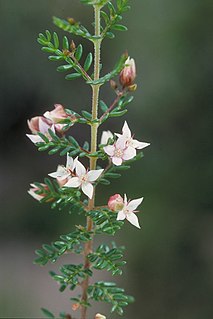
Boronia alulata is a plant in the citrus family, Rutaceae and is endemic to Cape York Peninsula. It is an erect shrub with many branches, pinnate leaves and pink or white, four-petalled flowers.
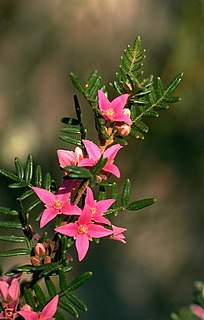
Boronia amabilis, commonly known as Wyberba boronia, is a plant in the citrus family, Rutaceae and is endemic to a small area in southern Queensland. It is an erect shrub with many branches, pinnate leaves with hairy lower surfaces and pink, four-petalled flowers.
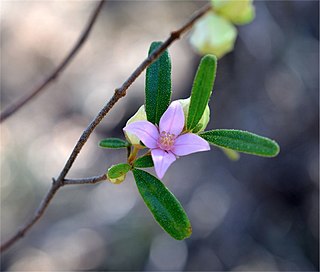
Boronia duiganiae is a plant in the citrus family Rutaceae and is endemic to mountain ranges in south-east Queensland, Australia. It is an erect shrub with many branches, leaves with one, three or five leaflets, and pink to white, four-petalled flowers.

Boronia forsteri is a plant in the citrus family Rutaceae and is endemic to mountain ranges in central Queensland, Australia. It is an erect shrub with many branches, simple leaves with a densely hairy, pale underside, and pink, four-petalled flowers.

Boronia odorata is a plant in the citrus family Rutaceae and is endemic to the central highlands of Queensland, Australia. It is an erect shrub with many branches, mostly simple leaves and pink to white, four-petalled flowers.
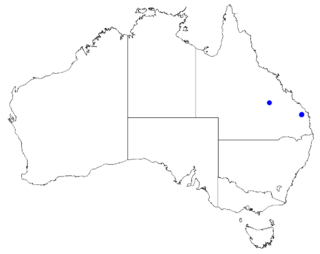
Boronia foetida is a plant in the citrus family Rutaceae and is endemic to a small area in Queensland. It is an erect shrub with hairy branches, simple leaves and pink to white, four-petalled flowers usually arranged singly in leaf axils. The leaves have an unpleasant smell when crushed.
Boronia hoipolloi is a plant in the citrus family Rutaceae and is endemic to a small area in Queensland. It is an erect or pendulous shrub with pinnate leaves and pink, four-petalled flowers. It is only known from a few collections near Mount Isa.

Boronia inflexa is a plant in the citrus family Rutaceae and is endemic to tablelands near the New South Wales - Queensland border in Australia. It is an erect, woody shrub with pinnate leaves and up to seven white to pink four-petalled flowers in the leaf axils. Boronia bipinnata is similar but has larger, bipinnate or tripinnate leaves and smaller sepals and petals.

Boronia jensziae, commonly known as Andy Jensz's boronia or Hinchinbrook boronia, is a plant in the citrus family Rutaceae and is endemic to Hinchinbrook Island in Queensland. It is an erect, densely branched shrub with simple leaves and pink to white, four-petalled flowers usually arranged singly in leaf axils.
Boronia montimulliganensis is a plant in the citrus family Rutaceae and is endemic to a single mountain in Queensland. It is an erect, woody shrub with pinnate or bipinnate leaves and white, four-petalled flowers usually arranged singly in leaf axils.
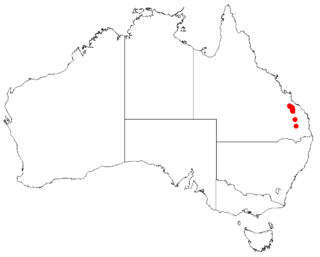
Boronia palasepala is a plant in the citrus family Rutaceae and is endemic to a small part of Queensland, Australia. It is an erect, rounded shrub with many branches, simple leaves and pink to white, four-petalled flowers.

Boronia parviflora, commonly known as the swamp boronia, small boronia, tiny boronia, or small-flowered boronia, is a plant in the citrus family Rutaceae and is endemic south-eastern Australia. It is a weak, low shrub with elliptic to egg-shaped leaves with finely toothed edges and up to three pink, white or green four-petalled flowers arranged at or near the ends of the stems.
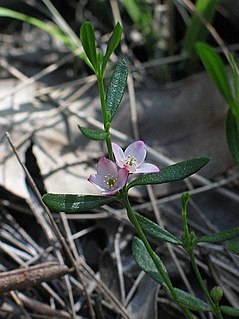
Boronia polygalifolia, commonly known as dwarf boronia, milkwort-leaved boronia or milkwort boronia, is a plant in the citrus family Rutaceae and is endemic to eastern Australia. It is a low-lying shrub with simple leaves and white or pink flowers arranged singly or in groups of up to three in leaf axils.

Boronia quinkanensis is a species of plant in the citrus family Rutaceae and is endemic to a small part of Queensland, Australia. It is an erect shrub with most parts covered with star-like hairs and has pinnate leaves with up to eleven leaflets, and pink to white, four-petalled flowers.
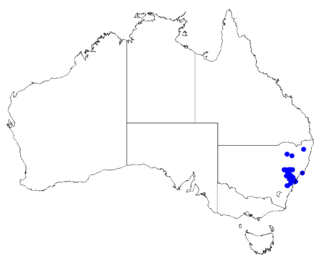
Boronia rubiginosa is a plant in the citrus family Rutaceae and is endemic to New South Wales in Australia. It is a shrub with pinnate leaves that are paler on the lower surface, and up to three pale to bright pink, four-petalled flowers in the leaf axils.

Boronia splendida is a species of plant in the citrus family, Rutaceae, and is endemic to Queensland, Australia. It is an erect shrub with most parts covered with star-like hairs and has simple, linear to narrow elliptic leaves, and pink to white, four-petalled flowers.

Boronia squamipetala is a species of plant in the citrus family, Rutaceae, and is endemic to Queensland, Australia. It is an erect shrub with pinnate leaves with between five and thirteen elliptic leaflets, and green to white, four-petalled flowers with hairy backs.

















